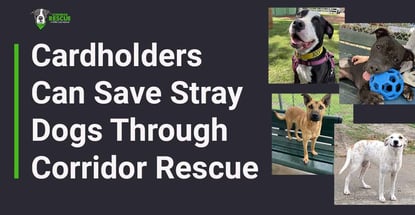
Our experts and industry insiders blog the latest news, studies and current events from inside the credit card industry. Our articles follow strict editorial guidelines.
In a Nutshell: The “Corridor of Cruelty” is a 14-square-mile area in Houston that has become a dumping ground for abandoned stray dogs and cats. The scenes of abuse there are as common as they are horrifying, and yet this region is a stone’s throw from downtown. Corridor Rescue is a nonprofit devoted to dealing with the situation. Animal-loving cardholders can support Corridor Rescue as it rescues, treats, and finds homes for abused dogs. It also neuters stray cats and models animal welfare dedication for other cities.
Houston is the fourth-largest US city, with a population of more than 2.3 million. So the existence of the “Corridor of Cruelty” perhaps shouldn’t surprise outsiders who don’t know the city well.
Yet the scenes of animal abandonment and cruelty manifested daily in the Corridor area are sure to horrify dog and cat lovers and make them wonder whether parts of America are reverting to a more primitive state.
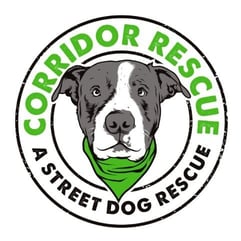
The Corridor, located outside Loop 610 north of downtown, is a 14-square-mile, low-income area in Houston where animals run wild, even if they have owners and homes. Because most of these dogs and cats aren’t spayed and neutered, they reproduce and lead to massive population overrun.
Much like areas that may have evolved into dumping grounds for garbage, the Corridor is a dumping ground for unwanted dogs and cats. It’s also a place where animal cruelty abounds, where dogs and cats are seen as nuisances and face malicious road traffic and even bullets that maim and kill.
One day in 2009, Deborah Hoffman was driving to work through the area and was inspired to do something about the horrors she observed. Corridor Rescue is the result.
Corridor Rescue is a nonprofit devoted to feeding and caring for the beleaguered dogs and cats of the Corridor, and rescuing and finding homes for as many dogs as possible.
It’s emotionally intense yet rewarding work, said Hoffman’s sister-in-law, Catherine Hoffman, who serves as Corridor Rescue’s Fundraising Director.
“There are plenty of good people living in these neighborhoods, but somehow it has become an area where people dump their dogs and leave them to fend for themselves,” Hoffman said. “Sometimes when we find them, it’s obvious they’ve been newly dumped, and they’re just waiting there, hoping that somebody’s coming back for them.”
Street Team Feeds Strays and Rescues Dogs
In a way, those naive former pets are the lucky ones. Hoffman told us one recently rescued dog had been shot and paralyzed and had lost control of his bladder and bowels.
Houston isn’t the only large American city with a stray dog and cat problem. But witnessing such concentrated misery only a few miles from the vibrancy of the business district has inspired many people in Houston to do what they can.
As a nonprofit, Corridor Rescue relies on donations to operate a street team that functions as boots on the ground in the Corridor. A kennel operation and a volunteer medical team perform triage and healing.
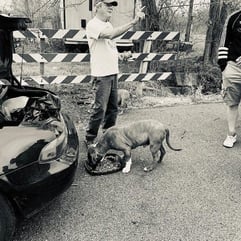
Corridor Rescue seeks volunteers to perform those duties, also with the foster caregiving and adoption teams, and to help Hoffman with organizational fundraising. Corridor Rescue applies for grants and holds fundraisers, but it mainly draws on individual donations. Cardholders with good hearts can support a cause that models effective animal advocacy that other cities can emulate.
Hoffman said the street team ventures out almost every day to places where stray dogs and cats congregate to distribute food and water. Depending on kennel space, the team rescues dogs for eventual adoption.
“We don’t necessarily know their injuries,” Hoffman said. “Sometimes they’re apparent injuries, but sometimes it takes a while after they get to the vet to find hidden injuries we don’t know about.”
Corridor Rescue never returns dogs to the wild. The team addresses their medical and behavioral needs from entering the system until they’re ready for human companionship.
“Some of these dogs are not very trusting, so they need a lot of behavioral therapy,” Hoffman said. “We put them in playgroups; when we can, we hire trainers to meet special needs.”
Seeking Foster Caregivers and Forever Homes
Usually a very gentle mixed breed, pit bulls are common strays in the Corridor because people enjoy the image of having a guard dog.
Because larger dogs are more challenging to care for, the mix among strays in the Corridor tends toward big dogs like pit bulls.
“People love to adopt small dogs — they get adopted right away,” Hoffman said. “But it takes a while for the larger dogs.”
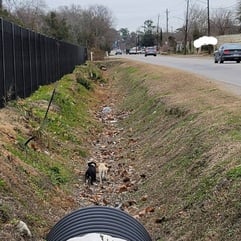
No matter the animals’ needs, the Corridor Rescue board is qualified to handle them. Donors may rest assured that the team has the expertise to diagnose and treat injuries and social maladjustment, obvious or not.
The board president, a veterinary technician, handles the medical aspects. Other board members include a real estate agent, a physical therapist assistant, a project director for a Fortune 500 company, and a travel industry professional. Together, the board and its volunteer group strive to alleviate the appalling conditions in the Corridor.
Folks in Houston may apply to adopt a dog on the Corridor Rescue website. The site sorts prospective adoptees by sex, attributes, age group, breed, and size. Dogs receive names when they enter the system.
Fostering is also an option. Corridor Rescue constantly looks for people willing to foster animals until they receive forever homes. At the time of our interview with Hoffman, she said the team was looking for a medical foster to take care of Balder, the dog described above that suffered a gunshot wound.
“He’s got a serious spinal injury — he drags his hind legs and has no pain feeling,” she said. “We’ve got him in the kennel now, but it’s open only about 10-11 hours a day, and the rest of the night, nobody is there to help him.”
Donations Support Kennel Upgrades and Care
The street team is also continually looking for volunteers. In addition to relieving animal suffering in the Corridor, the street team networks with community members to distribute resources.
Corridor Rescue issues vouchers to pay for spaying and neutering, provides transportation to people who don’t have any, helps with food and medical care, and educates the community. Hoffman said the work takes an emotional toll.
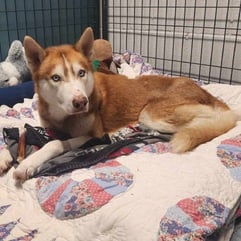
“Sometimes there’s an animal that just can’t be saved, and the best we can do is get them to the vet, where they’re humanely euthanized,” she said. “But we’ve also had some very emaciated dogs that have gone on to find homes.”
One dog particularly dear to Hoffman’s heart had a severe heartworm condition but was too fragile to sustain regular treatment. The team put her on a slow-kill preventative, which she eventually responded to.
“Knowing that we’ve created a better path for many of these animals is a rewarding experience,” Hoffman said.
Corridor Rescue has about a 40-dog capacity after it built a small kennel to supplement an original boarding facility — extremely meager given the level of animal privation in the Corridor. A small, caring, paid staff cares for and helps rehabilitate the dogs 7 days per week. Donations are needed to retrofit the safety features in the original kennel.
A recent Parvo outbreak in the facility seriously infected about 14 puppies. Parvo is a very serious illness that is highly contagious, leads to acute diarrhea, dehydration, and is very often fatal for puppies. The bill for hospitalization and treatment for those puppies exceeded $35,000, but Hoffman said abandoning them was never an option.
The network of recurring donors keeps the lights on, but Corridor Rescue can do more good with more support. Corridor Rescue also stands as an example of what a few dedicated people can accomplish on behalf of dogs and cats exposed to misery and shorter lives through no fault of their own. That’s an example other cities should emulate.
“There’s a lot of need across the board,” Hoffman said.





![How Do Balance Transfers Work? + 5 Top Offers ([updated_month_year]) How Do Balance Transfers Work? + 5 Top Offers ([updated_month_year])](https://www.cardrates.com/images/uploads/2016/04/complete-guide-to-balance-transfers.jpg?width=158&height=120&fit=crop)
![How Does a Secured Credit Card Work? (+ 5 Best Cards) – [updated_month_year] How Does a Secured Credit Card Work? (+ 5 Best Cards) – [updated_month_year]](https://www.cardrates.com/images/uploads/2016/10/how-does-a-secured-credit-card-work.jpg?width=158&height=120&fit=crop)
![How Do Credit Cards Work? Expert’s Guide ([updated_month_year]) How Do Credit Cards Work? Expert’s Guide ([updated_month_year])](https://www.cardrates.com/images/uploads/2017/04/how-do-credit-cards-work.jpg?width=158&height=120&fit=crop)
![How Does Credit Card Interest Work? ([updated_month_year]) How Does Credit Card Interest Work? ([updated_month_year])](https://www.cardrates.com/images/uploads/2017/07/interestworks.png?width=158&height=120&fit=crop)
![How Does a Prepaid Credit Card Work? ([updated_month_year]) How Does a Prepaid Credit Card Work? ([updated_month_year])](https://www.cardrates.com/images/uploads/2020/01/How-Does-a-Prepaid-Credit-Card-Work.jpg?width=158&height=120&fit=crop)